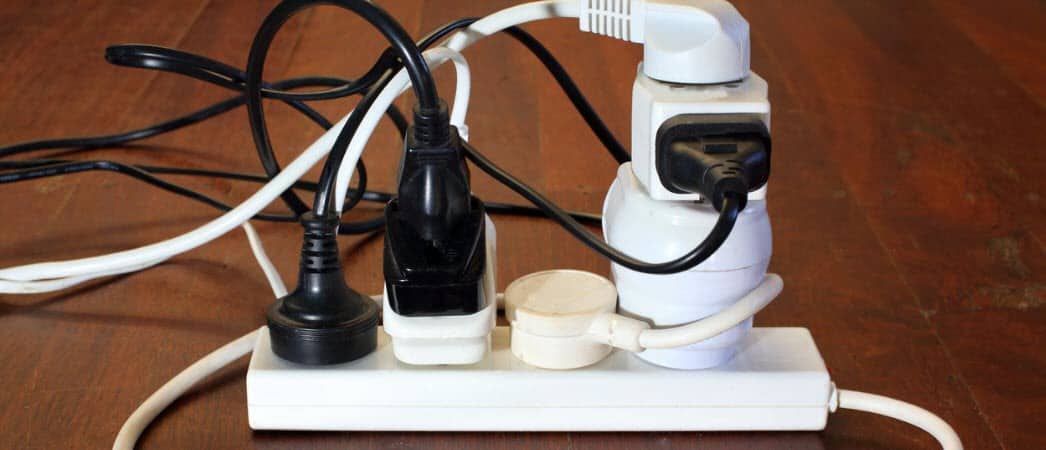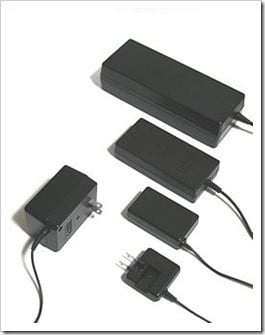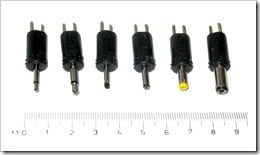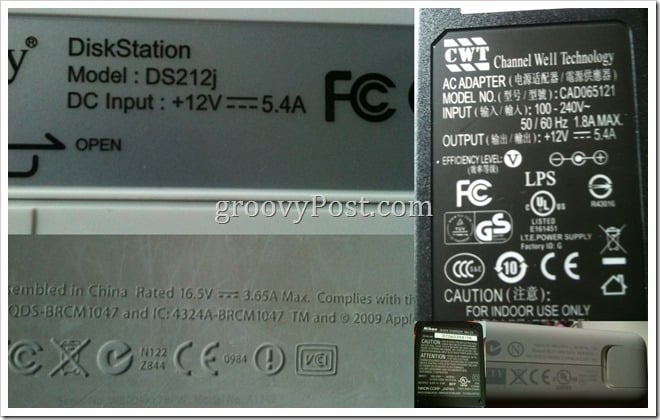Can I Use a 5v Adapter for 6v

Wait! Just considering the plug for that universal adapter fits into your laptop or telephone doesn't mean it's safety to use. Read this guide on finding the right charger or ability adapter.
The other weekend, I sat down and sorted through all my random electronics junk. As role of that process, I took all my ability supplies and adapters and threw them into a box. It ended up existence a pretty big box. I'grand willing to bet that any given household has a dozen or more different types of cell telephone chargers, AC/DC adapters, power bricks, ability cables, and charger plugs.

Having so many chargers tin can be pretty frustrating. It's easy to go them separated from the phone or laptop or tablet, or router. And in one case that happens, it can be complicated to figure out which goes with which. The default solution is to attempt random plugs until you find ane that fits into your device. Nonetheless, this is a big gamble. If y'all catch an incompatible power adapter, your best case scenario is that it works, albeit non the way the manufacturer intended. The 2d worst-case scenario is that you fry the gadget you are trying to power up. The worst-case scenario is that yous burn down your house.
In this article, I'grand going to walk yous through the procedure of digging through your junk drawer and finding the right power adapter for your device. Then, I'll tell you why it's so important to do and so.
In a nutshell:
- The following will cause impairment to your device:
- Reverse polarity
- Higher voltage adapter than device rating
- The following will cause harm to your power cord or adapter:
- Reverse polarity
- Lower current adapter than device rating
- The following might not cause harm, but the device will not piece of work properly:
- Lower voltage adapter than device rating
- College current adapter than device rating
A Very Cursory Introduction to Electrical Terminology
Each Ac/DC power adapter is specifically designed to take a certain AC input (usually the standard output from a 120 Five Ac outlet in your home) and convert it to a detail DC output. Besides, each electronic device is specifically designed to have a certain DC input. The key is to match the DC output of the adapter to the DC input of your device. Determining the outputs and inputs of your adapters and devices is the hard part.
Ability adapters are a flake like canned food. Some manufacturers put a lot of information on the label. Others put merely a few details. And if there is no information on the label, go on with extreme caution.
The most important details for you and your delicate electronics are the voltage and the current. Voltage is measured in volts (V), and current is measured in amps (A). (Yous've probably also heard well-nigh resistance (Ω), but this doesn't usually bear witness up on power adapters.)

To understand what these three terms mean, information technology helps to call back of electricity as water flowing through a pipe. In this analogy, the voltage would be the water pressure. Current, as the term implies, refers to the flow rate. And resistance relates to the size of the pipe. Tweaking any of these 3 variables increases or decreases the amount of electrical power sent to your device. It's important because too little ability means your device won't charge or operate correctly. Too much power generates excess heat, which is the bane of sensitive electronics.
The other important term to know is polarity. At that place is a positive pole (+) and a negative pole (-). For an adapter to work, the positive plug must mate with a negative receptacle or vice versa. By nature, direct electric current is a one-way street, and things won't piece of work if you try to go upward the downspout.
If you multiply the voltage by the current, you get the wattage. Only the number of watts lonely won't tell you if the adapter is right for your device.
Reading an Ac/DC Adapter Label

If the manufacturer was smart enough (or compelled by police) to include the DC output on the label, y'all are in luck. Look at the "brick" part of the adapter for the give-and-take OUTPUT. Here, you'll run across the volts followed by the direct current symbol and then the current.
The DC symbol looks similar this: ![]()
To check the polarity, await for a + or – sign adjacent to the voltage. Or, look for a diagram showing the polarity. It will usually consist of three circles, with a plus or minus on either side and a solid circle or C in the eye. If the + sign is on the correct, and so the adapter has positive polarity:
![]()
If in that location is a – sign on the right, then information technology has negative polarity:
![]()
Next, you want to look at your device for the DC input. You'll usually see at least the voltage well-nigh the DC plug receptacle. But yous also want to make sure the current matches, too.
Yous might find both the voltage and the current elsewhere on the device, on the bottom or inside a bombardment compartment cover, or in the transmission. Over again, look for the polarity by either noting a + or – symbol or the polarity diagram.
Remember: the input of the device should be the same equally the output of the adapter. This includes polarity. If the device has a DC input of +12V / 5.4A, get an adapter with a DC output of +12V / 5.4A. If you have a universal adapter, brand sure information technology has the proper current rating and cull the correct voltage and polarity.
Fudging It: What Happens if Y'all Use the Wrong Adapter?
 Ideally, you'll have the aforementioned voltage, current, and polarity on your adapter and device.
Ideally, you'll have the aforementioned voltage, current, and polarity on your adapter and device.
Simply what if you accidentally (or purposefully) use the wrong adapter? In some cases, the plug won't fit. But there are many instances where an incompatible power adapter will plug into your device. Here's what you can await in each scenario:
- The incorrect polarity – If you reverse the polarity, a few things can happen. If you're lucky, zip will happen, and no impairment will occur. If you are unlucky, your device will exist damaged. At that place's a centre basis, too. Some laptops and other devices include polarity protection, which is essentially a fuse that burns out if you utilise the wrong polarity. If this happens, yous might hear a pop and meet smoke. But the device may yet work on battery power. Even so, your DC input will exist toast. To fix this, either supervene upon the polarity protection fuse or get it serviced. The good news is that the main circuitry wasn't fried.
- Voltage also low – If the voltage on an adapter is lower than the device, but the current is the aforementioned, then the device may work, albeit erratically. If nosotros think dorsum to our analogy of voltage being water pressure, information technology would mean that the device has "depression blood pressure." The effect of low voltage depends on the complexity of the device. A speaker, for case, might be okay, just it won't get every bit loud. More sophisticated devices volition falter and may even shut themselves off when they detect an under-voltage condition. Usually, an under-voltage condition won't cause damage or shorten the life of your device.
- Voltage too loftier – If the adapter has a college voltage, but the current is the same, then the device volition likely shut itself off when information technology detects an overvoltage. If it doesn't, information technology may run hotter than normal, which can shorten the device's life or cause immediate damage.
- Electric current too high – If the adapter has the correct voltage, but the electric current is greater than what the device input requires, you lot shouldn't run across any problems. For case, if you have a laptop that calls for a 19V / 5A DC input, only you use a 19V / 8A DC adapter, your laptop will nevertheless get the 19V voltage it requires, but it will but depict 5A of electric current. Every bit far as current goes, the device calls the shots, and the adapter will accept to practice less work.
- Current as well Low – If the adapter has the correct voltage, just the adapter's rated current is lower than what the device input, then a few things might happen. The device could ability on and describe more current from the adapter than information technology's designed for. This could cause the adapter to overheat or neglect. Or, the device may ability on, but the adapter may non be able to keep upwardly, causing the voltage to driblet (run across voltage too low above). For laptops running on undercurrent adapters, you might run into the battery accuse, but the laptop is not powering on, or it may run on ability, just the battery won't accuse. Bottom line: information technology's a bad thought to use a lower current rating adapter since information technology could cause backlog estrus.
Y'all would expect to encounter all of the to a higher place based on a simple agreement of polarity, voltage, and current. What these outlooks don't have into account is the diverse protections and versatility of adapters and devices. Manufacturers may besides build a fleck of a cushion into their ratings. For example, your laptop may be rated for an 8A depict, but in reality, it only draws effectually 5A. Conversely, an adapter may exist rated at 5A, but tin withstand currents up to 8A. Also, some adapters and devices volition take voltage and current switching or detecting features that will adjust the output/draw depending on what's needed. And, as mentioned above, many devices will automatically shut down before it causes damage.
That being said, I don't recommend fudging the margin under the assumption that you can practise the equivalent of driving five MPH over the speed limit with your electronic devices. The margin is there for a reason, and the more than complicated the device, the more potential for something to go wrong.
Have any cautionary tales about using the wrong AC/DC adapter? Warn us in the comments!

P.S. Wall adapters that requite you a USB port for charging aren't nearly as tricky. Standard USB devices accept a 5 V dc voltage and a electric current up to .five A or 500 mA for charging merely. This is what allows them to play nice with the USB ports on your computer. Most USB wall adapters will be five V adapters and have a current rating well over .5 A. The iPhone USB wall adapter I'thou holding in my mitt correct at present is five V / 1 A. Y'all also don't accept to worry about polarity with USB. A USB plug is a USB plug, and all you usually accept to worry virtually is a class factor (e.chiliad., micro, mini, or standard). Furthermore, USB devices are smart enough to close things down if something isn't right. Hence, the oft-encountered "Charging is not supported with this accessory" message.
Feature image by Qurren – GFDL (http://www.gnu.org/copyleft/fdl.html) or CC-BY-SA-3.0 (http://creativecommons.org/licenses/past-sa/iii.0/), via Wikimedia Commons

Source: https://www.groovypost.com/howto/choose-right-power-adapter-charger-phone-laptop/
0 Response to "Can I Use a 5v Adapter for 6v"
Post a Comment